Lexus LX450 2005, LX470 2005, LX570 2005 Owner Manual

SECTION 6 ± 5
SERVICE PROCEDURES AND
SPECIFICATIONS
Body
Specifications . . . . . . . . . . . . . . . . . . . . . . . . . . . . . . . . . . . . . . . . . . . . . . . . . . . . . . . . . . . . . . . . . . . . . 416 Protecting your vehicle from corrosion . . . . . . . . . . . . . . . . . . . . . . . . . . . . . . . . . . . . . . . . . . . . . . . . 417 Washing and waxing . . . . . . . . . . . . . . . . . . . . . . . . . . . . . . . . . . . . . . . . . . . . . . . . . . . . . . . . . . . . . . . . 418 Cleaning the interior . . . . . . . . . . . . . . . . . . . . . . . . . . . . . . . . . . . . . . . . . . . . . . . . . . . . . . . . . . . . . . . . 420
415

BODY
SPECIFICATIONS
± DIMENSIONS AND WEIGHTS
Overall length |
4890 mm (192.5 in.) |
|
|
Overall width |
1940 mm (76.4 in.) |
|
|
Overall height |
1850 mm (72.8 in.)* |
|
|
Wheelbase |
2850 mm (112.2 in.) |
|
|
Tread ± Front |
1620 mm (63.8 in.) |
± Rear |
1615 mm (63.6 in.) |
|
|
Vehicle capacity weight (occupants + cargo) |
545 kg (1200lb.) |
|
|
Towing capacity (trailer weight + cargo weight) |
2268 kg (5000lb.) |
|
|
*: Unladen vehicle |
|
± FUEL TANK |
|
Capacity |
96 L (25.4 gal., 21.1 lmp.gal.) |
|
|
416

BODY
PROTECTING YOUR VEHICLE
FROM CORROSION
Proper care of your Lexus can help ensure long±term corrosion prevention.
The most common causes of corrosion to your vehicle are:
The accumulation of road salt, dirt and moisture in hard±to±reach areas under the vehicle.
Chipping of paint or undercoating caused by minor accidents or by stones and gravel.
The following conditions will cause or accelerate corrosion of your vehicle, so it is important to keep your vehicle, particularly the underside, as clean as possible and to repair any damage to paint or protective coatings as soon as possible.
The presence of road salt or dust control chemicals, salt in the air near the sea coast, industrial air pollution.
High humidity, especially at temperatures just above freezing point.
Certain parts of your vehicle are wet or damp for an extended period of time, even though other parts of the
vehicle are dry.
Components of the vehicle which are prevented from quick±drying due to lack of proper ventilation are exposed
to high ambient temperature.
To help prevent corrosion on your Lexus, follow these guidelines:
Keep your vehicle clean by regular washing. In addition, observe the following points.
If you drive on salted roads in the winter or if you live near the ocean, you should hose off the undercarriage at least
once a month to minimize corrosion.
High pressure water or steam is effective for cleaning the vehicle's underside and wheel housings. Pay particular attention to these areas as it is difficult to see all the mud and dirt. It will do more harm than good to simply wet the mud and debris without removing them. The lower edge of doors, rocker panels and frame members have drain holes which should not be allowed to clog with dirt as trapped
water in these areas can cause corrosion.
Wash the underside of the vehicle thoroughly when winter is over.
See ªWashing and waxingº on page 418 for more tips.
Check the condition of your vehicle's paint and trim. If you find any chips or scratches in the paint, touch them up immediately to prevent corrosion from starting. If the chips or scratches have gone through the bare metal, have a qualified body shop make the repair.
417

BODY
Check the interior of your vehicle. Water and dirt can accumulate under the floor mats and could cause corrosion. Occasionally check under the mats to make sure the area is dry. Be particularly careful when transporting chemicals, cleansers, fertilizers, salt, etc. These should be transported in proper containers. If a spill or leak should occur, immediately clean and dry the area.
Use mud shields on your wheels. If you drive on salted or gravel roads, mud shields help protect your vehicle. Full±size shields, which come as near to the ground as possible, are the best. We recommend that the fittings and the area where the shields are installed be treated to resist corrosion. Your Lexus dealer will be happy to assist in supplying and installing the shields if they are recommended for your area.
Keep your vehicle in a well ventilated garage or a roofed place. Do not park your vehicle in a damp, poorly ventilated garage. If you wash your vehicle in the garage, or if you drive it covered with water or snow, your garage may be so damp as to cause corrosion. Even if your garage is heated, a wet vehicle can corrode if the ventilation is poor.
WASHING AND WAXING
Washing your Lexus
Keep your vehicle clean by regular washing.
The following cases may cause weakness to the paint or corrosion to the body and parts. Wash your vehicle as soon as possible.
When driving in a coastal area
When driving on a road sprinkled with antifreeze
When exposed to coal tar, tree sap, bird droppings and carcass of an insect
When driving in areas where there is a lot of smoke, soot, dust, iron dust or chemical substances
When the vehicle becomes remarkably dirty with dust and mud
Hand±washing your Lexus
Work in the shade and wait until the vehicle body is not hot to the touch.
1.Rinse off loose dirt with a hose. Remove any mud or road salt from the underside of the vehicle or in the wheel wells.
2.Wash with a mild car±wash soap, mixed according to the manufacturer's instructions. Use a soft cotton mitt and keep it wet by dipping it frequently into the wash water. Do not rub hard ± let the soap and water remove the dirt.
418
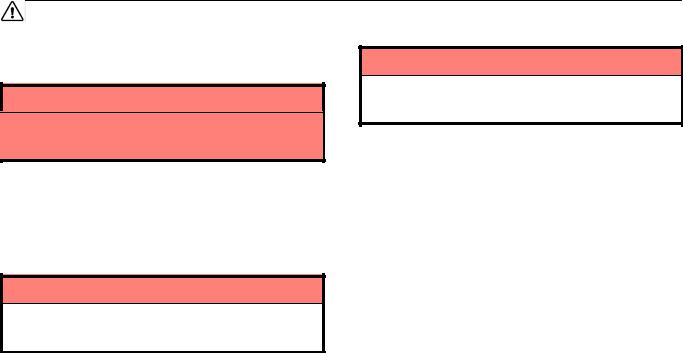
BODY
Plastic wheel ornaments: The plastic wheel ornaments are damaged easily by organic substances. If any organic substance splashes an ornament, be sure to wash it off with water and check if the ornament is damaged.
CAUTION
Do not attach the heavily damaged plastic wheel ornament. It may fly off the wheel and cause accidents while the vehicle is moving.
Aluminum wheels: Use only a mild soap or neutral detergent.
Urethane bumpers and side moldings: Wash carefully. Do not scrub with abrasive cleaners. The bumper and side molding faces are soft.
Road tar: Remove with turpentine or cleaners that are marked safe for painted surfaces.
NOTICE
Do not use organic substances (gasoline, kerosene, benzine or strong solvents), which may be toxic or cause damage.
3.Rinse thoroughly ± dried soap can cause streaking. In hot weather you may need to rinse each section right after you wash it.
4.To prevent water spots, dry the vehicle using a clean soft cotton towel. Do not rub or press hard ± you might scratch the paint.
Automatic car wash
NOTICE
To prevent damage to the antenna, make sure it is retracted before driving your vehicle through an automatic car wash.
Your vehicle may be washed in an automatic car wash, but remember that the paint can be scratched by some types of brushes, unfiltered washing water, or the washing process itself. Scratching reduces paint durability and gloss, especially on darker colors. The manager of the car wash should be able to advise you whether the process is safe for the paint on your vehicle.
Waxing your Lexus
Polishing and waxing is recommended to maintain the original beauty of your Lexus' finish.
Apply wax once a month or if the vehicle surface does not repel water well.
1.Always wash and dry the vehicle before you begin waxing, even if you are using a combined cleaner and wax.
2.Use a good quality polish and wax. If the finish has become extremely weathered, use a car±cleaning polish, followed by a separate wax. Carefully follow the manufacturer's instructions and precautions. Be sure to polish and wax the chrome trim as well as the paint.
419

BODY
3. Wax the vehicle again when water does not bead but remains on the surface in large patches.
Windshield washer nozzles: Make sure the washer nozzles do not become blocked. If a nozzle becomes blocked, contact your Lexus dealer to have the vehicle serviced.
NOTICE
If a nozzle becomes blocked, do not try to clear it with a pin or other object. The nozzle will be damaged.
CLEANING THE INTERIOR
CAUTION
Be careful not to splash water or spill liquid on the floor. This may prevent the side airbags from activating correctly, resulting in serious injury.
Do not wash the vehicle floor with water, or allow water to get onto the floor when cleaning the vehicle interior or exterior. Water may get into audio components or other electrical components above or under the floor carpet (or mat) and cause a malfunction; and it may cause body corrosion.
Leather±trimmed interior
Remove dirt using a soft cloth dampened with 5 % solution of neutral detergent for wool. Then thoroughly wipe off all traces of detergent with a clean damp cloth.
After cleaning or whenever any part of the leather gets wet, dry with a soft clean cloth. Allow the leather to dry in a ventilated shaded area.
420
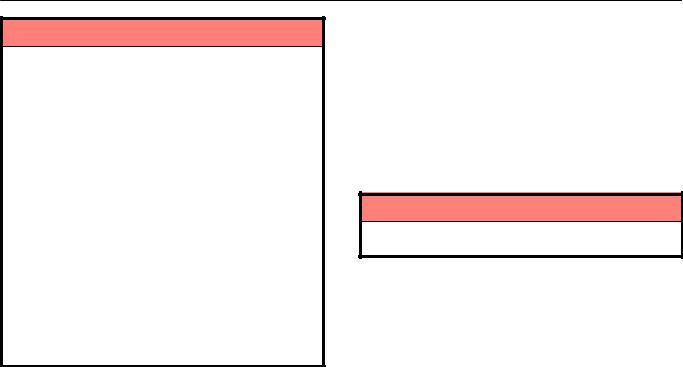
BODY
NOTICE
If a stain should fail to come out with a neutral detergent, apply a cleaner that does not contain an organic solvent.
Never use organic substances such as benzine, alcohol or gasoline, or alkaline or acid solutions for cleaning the leather as these could cause discoloring.
Use of a nylon brush or synthetic fiber cloth, etc. may scratch the fine grained surface of the leather.
Mildew may develop on soiled leather upholstery. Be especially careful to avoid oil spots. Try to keep your upholstery always clean.
Long exposure to direct sunlight may cause the leather surface to harden and shrink. Keep your vehicle in a shaded area, especially in the summer.
The interior of your vehicle is apt to heat up on hot summer days, so avoid placing on the upholstery items made of vinyl or plastic or containing wax as these tend to stick to leather when warm.
Improper cleaning of the leather upholstery could result in discoloration or staining.
Non±leather trim (Part of door panels)
The non±leather trim may be easily cleaned with a mild soap or detergent and water.
First vacuum over the upholstery to remove loose dirt. Then, using a sponge or soft cloth, apply the soap solution to the non±leather trim. After allowing it to soak in for a few minutes to loosen the dirt, remove the dirt and wipe off the soap with a clean damp cloth. If all the dirt does not come off, repeat the procedure. Commercial foaming±type cleaners are also available which work well. Follow the manufacturer's instructions.
NOTICE
Do not use solvent, thinner, gasoline or window cleaner on the interior.
421
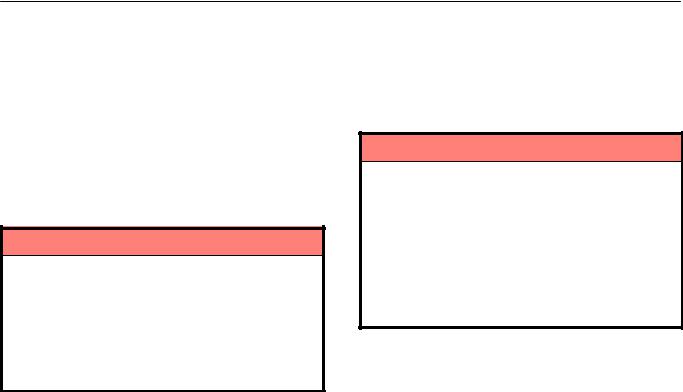
BODY
Carpets, Windows and Seat Belts
Begin by vacuuming thoroughly to remove as much dirt as possible. Several types of foam cleaners are available; some are in aerosol cans and others are powders or liquids which you mix with water to produce a foam. To shampoo the carpets, use a sponge or brush to apply the foam. Rub in overlapping circles. Do not apply water ± the best results are obtained by keeping the carpet as dry as possible. Read the shampoo instructions and follow them closely.
The seat belts may be cleaned with mild soap and water or with lukewarm water.
Use a cloth or sponge. As you are cleaning, check the belts for excessive wear, fraying or cuts.
NOTICE
Use a good foam±type shampoo to clean the carpets.
Do not use dye or bleach on the belts ± it may weaken them.
Do not use the belts until they become dry.
The windows may be cleaned with any household window cleaner.
When cleaning the inside of the rear window, be careful not to scratch or damage the heater wires.
Air Conditioning Control Panel, Audio
System, Instrument Panel, Console Panel,
and Switches
Use a soft damp cloth for cleaning.
Soak a clean soft cloth in water or lukewarm water then lightly wipe off any dirt.
NOTICE
Do not use organic substances (solvents, kerosene, alcohol, gasoline, etc.) or alkaline or acidic solutions. These chemicals can cause discoloring, staining or peeling of the surface.
If you use cleaners or polishing agents, make sure their ingredients do not include the substances mentioned above.
If you use a liquid car freshener, do not spill the liquid onto the vehicle's interior surfaces. It may contain the ingredients mentioned above. Immediately clean any spill using the method mentioned above.
If you have any questions about the cleaning of your Lexus, your local Lexus dealer will be pleased to answer them.
422

SECTION 6 ± 1
SERVICE PROCEDURES AND
SPECIFICATIONS
Introduction
Vehicle identification . . . . . . . . . . . . . . . . . . . . . . . . . . . . . . . . . . . . . . . . . . . . . . . . . . . . . . . . . . . . . . . . 350 Theft prevention labels . . . . . . . . . . . . . . . . . . . . . . . . . . . . . . . . . . . . . . . . . . . . . . . . . . . . . . . . . . . . . . 351 Engine compartment overview . . . . . . . . . . . . . . . . . . . . . . . . . . . . . . . . . . . . . . . . . . . . . . . . . . . . . . . 352 Do±it±yourself service precautions . . . . . . . . . . . . . . . . . . . . . . . . . . . . . . . . . . . . . . . . . . . . . . . . . . . 353 Parts and tools . . . . . . . . . . . . . . . . . . . . . . . . . . . . . . . . . . . . . . . . . . . . . . . . . . . . . . . . . . . . . . . . . . . . . 354
349
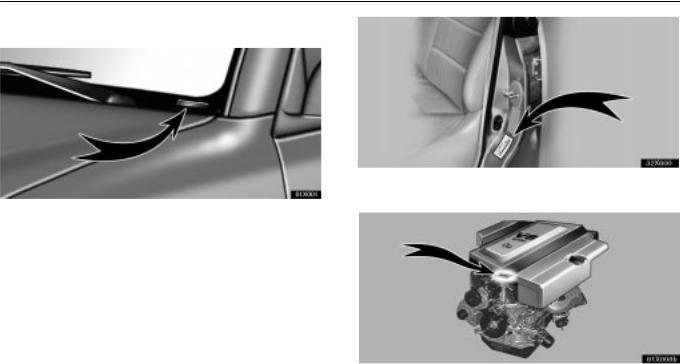
INTRODUCTION
VEHICLE IDENTIFICATION
The vehicle identification number (VIN) is the legal identifier for your vehicle. This number is on the left top of the instrument panel and can be seen through the windshield from outside.
This is the primary identification number for your Lexus. It is used in registering the ownership of your vehicle.
The vehicle identification number (VIN) is also on the Certification Label.
The engine number is stamped on the engine block as shown.
350
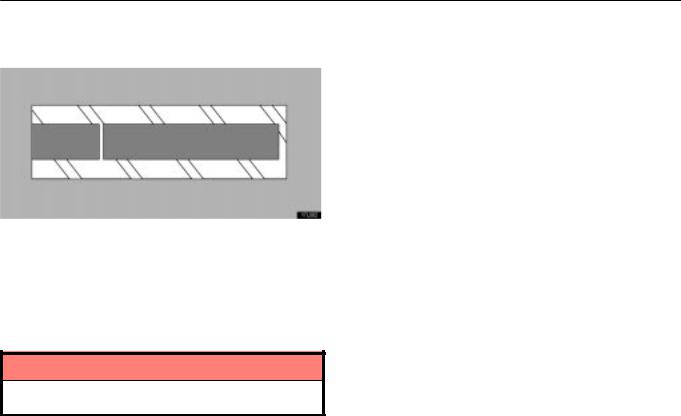
INTRODUCTION
THEFT PREVENTION LABELS (U.S.A.ONLY)
Your new vehicle carries theft prevention labels which are approximately 56 mm (2.20 in.) by 16 mm (0.63 in.).
The purpose of these labels is to reduce the incidence of vehicle thefts by facilitating the tracing and recovery of parts from stolen vehicles. The label is designed so that once it is applied to a surface, any attempt to remove it will result in destroying the integrity of the label. Transferring these labels intact from one part to another will be impossible.
NOTICE
You should not attempt to remove the theft prevention labels as it may violate certain state or federal laws.
351
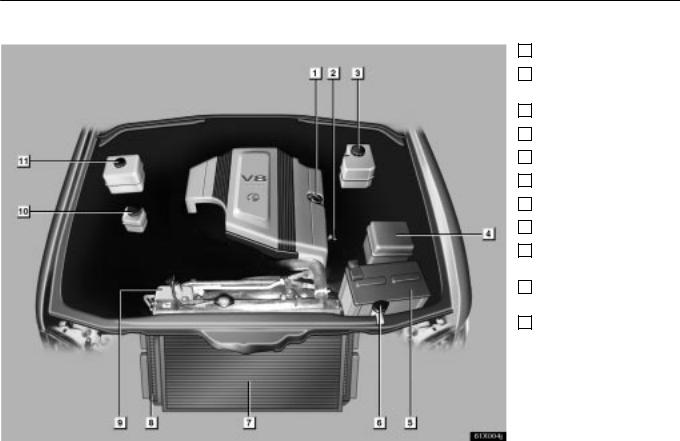
INTRODUCTION
ENGINE COMPARTMENT OVERVIEW
1 Engine oil filler cap
2 Engine oil level dipstick
3 Brake fluid reservoir
4 Fuse box
5 Battery
6 Washer fluid tank
7 Condenser
8 Radiator
9 Engine coolant reservoir
10 Power steering fluid reservoir
11 Suspension fluid reservoir
352
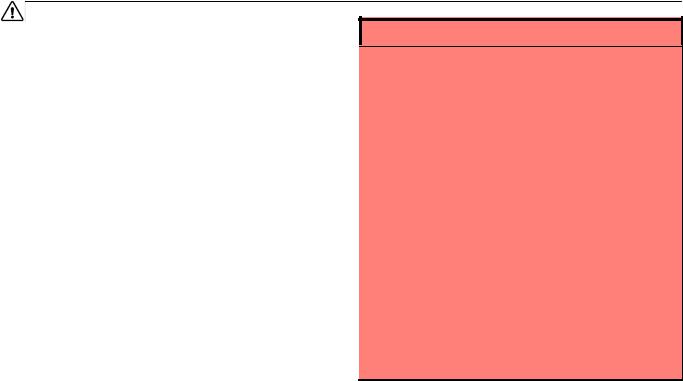
INTRODUCTION
DO±IT±YOURSELF SERVICE
PRECAUTIONS
If you perform maintenance yourself, be sure to follow the correct procedure given in this Section.
You should be aware that improper or incomplete servicing may result in operating problems.
Performing do±it±yourself maintenance during the warranty period may affect your warranty coverage. Read the separate Lexus Warranty statement for details and suggestions.
This Section gives instructions only for those items that are relatively easy for an owner to perform. As explained in Section 5, there are still a number of items that must be performed by a qualified technician with special tools.
For information on tools and parts for do±it±yourself maintenance, see ªParts and toolsº on page 354.
Utmost care should be taken when working on your vehicle to prevent accidental injury. Here are a few precautions that you should be especially careful to observe:
CAUTION
When the engine is running, keep hands, clothing, and tools away from the moving fan and engine drive belt. (Removing rings, watches, and ties is advisable.)
Right after driving, the engine compartment ± the engine, radiator, exhaust manifold and power steering fluid reservoir and spark plug boots, etc. ± will be hot. So be careful not to touch them. Oil, other fluids and spark plugs may also be hot.
If the engine is hot, do not remove the radiator cap or loosen the drain plugs to prevent burning yourself.
Do not smoke, cause sparks or allow open flames around fuel or the battery. Their fumes are flammable.
Do not get under your vehicle with just the body jack supporting it. Always use automotive jack stands or other solid supports.
Use eye protection whenever you work on or under your vehicle where you may be exposed to flying or falling material, fluid spray, etc.
Be extremely cautious when working on the battery. It contains poisonous and corrosive sulfuric acid.
353
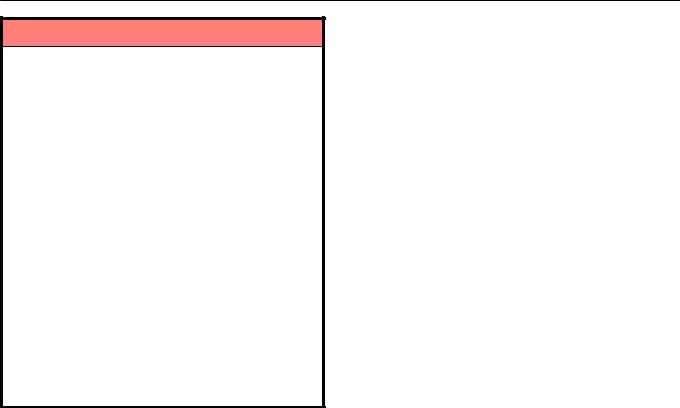
INTRODUCTION
NOTICE
Remember that battery and ignition cables carry high currents or voltages. Be careful of accidentally causing a short circuit.
Add only ªToyota Super Long Life Coolantº or similar high quality ethylene glycol based non±silicate, non±amine, non±nitrite, and non±borate coolant with long±life hybrid organic acid technology to fill the radiator. ªToyota Super Long Life Coolantº is a mixture of 50% coolant and 50% deionized water (for the U.S.A.) or 55% coolant and 45% deionized water (for Canada).
If you spill some of the coolant, be sure to wash it off with water to prevent it from damaging the parts or paint.
Before closing the engine hood, check to see that you have not forgotten any tools, rags, etc.
Do not drive with the air cleaner removed, or excessive engine wear could result. Also backfiring could cause a fire in the engine compartment.
Do not overfill automatic transmission fluid, transfer oil and power steering fluid, or the transmission, transfer and power steering could be damaged.
Be careful not to scratch the glass surface with the wiper frame.
PARTS AND TOOLS
Here is a list of parts and tools you will need to perform do±it±yourself maintenance. Remember all Lexus parts are designed in metric sizes, so your tools must be metric.
Checking the engine oil level
Parts (if level is low):
ªToyota Genuine Motor Oilº or equivalent
Oil grade: API grade SL ªEnergy±Conservingº or ILSAC multigrade engine oil. For recommended oil viscosity, see
page 367.
Tools:
Rag or paper towel
Funnel (only for adding oil)
Checking the engine coolant level
Parts (if level is low):
ªToyota Super Long Life Coolantº or similar high quality ethylene glycol based non±silicate, non±amine, non±nitrite, and non±borate coolant with long life hybrid organic acid
technology.
ªToyota Super Long Life Coolantº is a mixture of 50%coolant and 50% deionized water (for the U.S.A.) or 55% coolant
and 45% deionized water (for Canada).
Tools:
Funnel (only for adding coolant)
354

INTRODUCTION
Checking brake fluid
Parts (if level is low):
FMVSS No. 116 DOT 3 or SAE J1703 brake fluid
Tools:
Rag or paper towel
Funnel (only for adding fluid)
Checking power steering fluid
Parts (if level is low):
Automatic transmission fluid DEXRON II or III
Tools:
Rag or paper towel
Funnel (only for adding fluid)
Checking suspension fluid AHC
Parts (if level is low):
Suspension fluid AHC
Tools:
Rag or paper towel
Funnel (only for adding fluid)
Checking battery condition
Tools:
Warm water
Baking soda
Grease
Conventional wrench (for terminal clamp bolts)
Checking and replacing the blade type fuses
Parts (if replacement is necessary):
Fuse with same amperage rating as original
Checking the cartridge type fuses
Parts (if replacement is necessary):
Genuine Lexus fuse or equivalent with same amperage rating as original
Adding washer fluid
Parts:
Water
Washer fluid containing antifreeze (for winter use)
Tools:
Funnel
355
INTRODUCTION
356

SECTION 1 ± 5
INSTRUMENTS AND CONTROLS
Exterior equipment
Hood . . . . . . . . . . . . . . . . . . . . . . . . . . . . . . . . . . . . . . . . . . . . . . . . . . . . . . . . . . . . . . . . . . . . . . . . . . . . . . 92 Fuel tank cap . . . . . . . . . . . . . . . . . . . . . . . . . . . . . . . . . . . . . . . . . . . . . . . . . . . . . . . . . . . . . . . . . . . . . . . 93 Moon roof . . . . . . . . . . . . . . . . . . . . . . . . . . . . . . . . . . . . . . . . . . . . . . . . . . . . . . . . . . . . . . . . . . . . . . . . . . 95 Rear step bumper . . . . . . . . . . . . . . . . . . . . . . . . . . . . . . . . . . . . . . . . . . . . . . . . . . . . . . . . . . . . . . . . . . . 98 Running board lights . . . . . . . . . . . . . . . . . . . . . . . . . . . . . . . . . . . . . . . . . . . . . . . . . . . . . . . . . . . . . . . . . 98
91
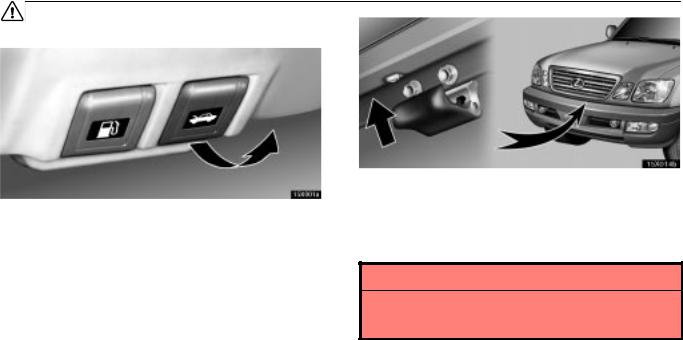
EXTERIOR EQUIPMENT
HOOD
1. To open the hood, pull the hood lock release lever under the instrument panel. The hood will spring up slightly.
2. Insert your fingers under the hood, push up the auxiliary catch lever and lift the hood.
Before closing the hood, check to see that you have not forgotten any tools, rags, etc. Then lower the hood and make sure it locks.
CAUTION
Before driving, be sure that the hood is closed and securely locked. Otherwise, the hood may open unexpectedly while driving and an accident may occur.
92
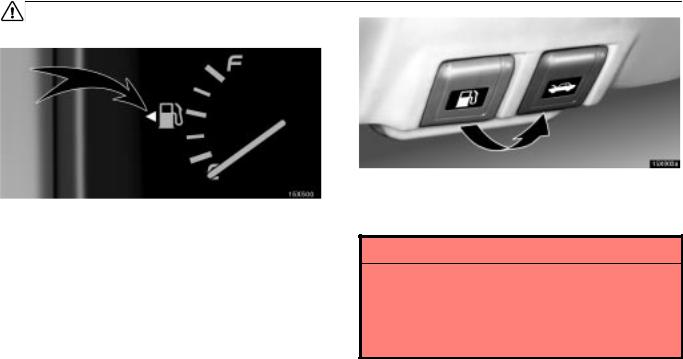
EXTERIOR EQUIPMENT
FUEL TANK CAP
The arrow head next to  as shown indicates on which side of your vehicle the fuel filler door is located.
as shown indicates on which side of your vehicle the fuel filler door is located.
1. To open the fuel filler door, pull the lever under the instrument panel.
When refueling, turn off the engine.
CAUTION
Do not smoke, cause sparks or allow open flames when refuelling. The fumes are flammable.
When opening the cap, do not remove the cap quickly. In hot weather, fuel under pressure could cause injury by spraying out of the filler neck if the cap is suddenly removed.
93

EXTERIOR EQUIPMENT
2. To remove the fuel tank cap, turn the cap slowly counterclockwise, then pause slightly before removing it. The removed cap can be stored on the back side of the fuel filler door.
It is not unusual to hear a slight swoosh when the cap is opened. When installing the cap, turn the cap clockwise until you hear a click.
If the cap is not tightened securely, the malfunction indicator lamp comes on. Make sure the cap is tightened securely.
The indicator lamp goes off after driving several times. If the indicator lamp does not go off, contact your Lexus dealer as soon as possible.
CAUTION
Make sure the cap is installed securely to prevent fuel spillage in the event of an accident.
Use only a genuine Lexus fuel tank cap for replacement. It is designed to regulate fuel tank pressure.
94
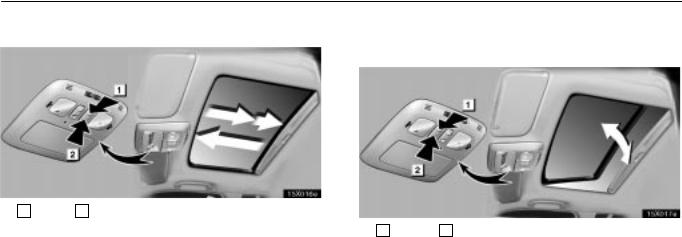
EXTERIOR EQUIPMENT
MOON ROOF
1 Open 2 Close
To slide open the moon roof, push the ªSLIDEº switch on the rear side. The moon roof will open and stop partway 30 mm (1.2 in.) from the fully opened position. When you push the switch again, the moon roof will open fully. To stop partway, push the same switch or push the ªTILTº switch while the moon roof is moving.
As driving with the moon roof opened fully will cause wind throbs, we recommend you to drive with the moon roof partway 30 mm (1.2 in.) from the fully opened position.
To operate the moon roof, the ignition key must be in the ªONº position.
The sun shade can be opened or closed manually. However, if you open the moon roof, the sun shade will be opened with the moon roof.
To close the moon roof, push the switch on the front side. The moon roof will fully close. To stop partway, push the same switch or ªTILTº switch.
1 Tilt up 2 Lower
To tilt up the rear end of the moon roof, push the ªTILTº switch on the rear side. The rear end of the moon roof will tilt up fully. To stop partway, push the same switch or ªSLIDEº switch.
To lower it, push the switch on the front side. The rear end of the moon roof will fully close. To stop partway, push the same switch or ªSLIDEº switch.
Retained accessory power: Even if the ignition key is turned to the ªACCº or ªLOCKº position with all the doors closed, the moon roof can be operated until either of the front doors is opened (or for about 45 seconds).
95

EXTERIOR EQUIPMENT
Operating the moon roof from outside the vehicle
The moon roof can be closed or opened using a key.*
Insert the ignition key into the key hole on the driver's door.
To close the moon roof: Turn the key in the locking direction and hold it.
After the door is locked, the moon roof begins to close. To stop in the middle, return the key.
To open the moon roof: Turn the key in the unlocking direction and hold it.
After the door is unlocked, the moon roof begins to open. To stop in the middle, return the key.
NOTE: *This feature can be deactivated, or sliding open/close or tilting up/down can be selected. Ask your
Lexus dealer for details.
Jam protection function
If something gets caught into the roof opening during closing operation, the moon roof stops and is open.
If the moon roof receives a strong impact, this function may work even if nothing is caught.
If the battery terminal is disconnected or the battery is run down
The moon roof may not operate automatically and the jam protection function will not operate correctly after you reconnect, replace or recharge the battery with the moon roof slide±opened or tilted up. In any of these cases, you should return the moon roof to normal. To normalize the moon roof, push and hold the ªSLIDEº switch or ªTILTº switch onthe front side until the moon roof is closed completely.
Make sure the moon roof opens and closes automatically. If the moon roof cannot be operated properly, have it checked by your Lexus dealer.
96
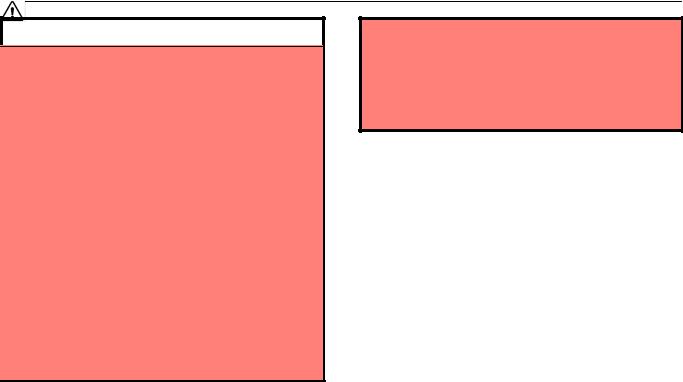
EXTERIOR EQUIPMENT
CAUTION
To avoid serious personal injury, you must do the following.
While the vehicle is moving, always keep the heads, hands and other parts of the bodies of all occupants away from the roof opening. Otherwise, they could be seriously injured if the vehicle stops suddenly or if the vehicle is involved in an accident.
Before you close the moon roof, always make sure there is nobody around the moon roof. You must also make sure nobody places his or her head, hands and other parts of the body in the roof opening. If someone's neck, head or hands get caught in the closing roof, it could result in death or serious injury. When anyone closes the moon roof, first make sure it is safe to do so.
Be sure to remove the ignition key when you leave your vehicle.
Never leave anyone (particularly death or small child) alone in your vehicle, especially with the ignition key still inserted. Otherwise, he/she could use the moon roof switches and get trapped in a moon roof. Unattended person (particularly a small child) can be involved in a serious accident.
Never sit on top of the vehicle around the roof opening.
Never try jamming any part of your body to activate the jam protection function intentionally.
The jam protection function may not work if something gets caught just before the moon roof fully closed.
97
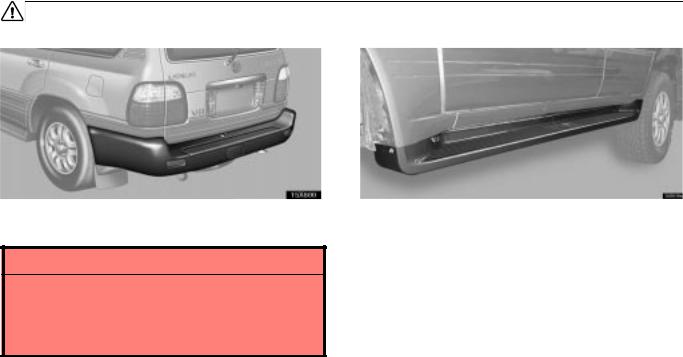
EXTERIOR EQUIPMENT
REAR STEP BUMPER |
RUNNING BOARD LIGHTS |
||||
|
|
|
|
|
|
|
|
|
|
|
|
The rear step bumper is for rear end protection and easier step±up loading.
CAUTION
Do not allow more than one person to get on the rear step bumper at a time. It is designed for only one person.
Never drive the vehicle with anyone on the rear step bumper.
Lighting the running board and the ground helps you easily to get in and out of the vehicle in the night.
When you unlock any door with a key or wireless remote control, the lights come on and go out after about 15 seconds automatically.
Opening any door lights up the lights and closing it goes out them after 15 seconds. However, if the door remains open, the lights automatically go out after about 30 minutes.
98

EXTERIOR EQUIPMENT
Cleaning ground lights
Ground light
If the mud or debris are sticking on the lense covers of the ground lights, the lights will dim. Wipe off them from the lens covers with a soft moist cloth periodically.
99
EXTERIOR EQUIPMENT
100

SECTION 7
REPORTING SAFETY DEFECTS
FOR U.S. OWNERS
Reporting safety defects for U.S. owners
Reporting safety defects for U.S. owners . . . . . . . . . . . . . . . . . . . . . . . . . . . . . . . . . . . . . . . . . . . . . . 424
423

REPORTING SAFETY DEFECTS FOR U.S. OWNERS
REPORTING SAFETY DEFECTS
FOR U.S. OWNERS
If you believe that your vehicle has a defect which could cause a crash or could cause injury or death, you should immediately inform the National Highway Traffic Safety Administration (NHTSA) in addition to notifying Toyota Motor Sales, U.S.A., Inc. (Toll±free: 1±800±25±LEXUS).
If NHTSA receives similar complaints, it may open an investigation, and if it finds that a safety defect exists in a group of vehicles, it may order a recall and remedy campaign. However, NHTSA cannot become involved in individual problems between you, your dealer, or Toyota Motor Sales, U.S.A., Inc.
To contact NHTSA, you may either call the Auto Safety Hotline toll±free at 1±800±424±9393 (or 366±0123 in Washington, D.C. area) or write to: NHTSA, U.S. Department of Transportation, Washington, D.C. 20590. You can also obtain other information about motor vehicle safety from the Hotline.
424

SECTION 6 ± 4
SERVICE PROCEDURES AND
SPECIFICATIONS
Electrical components
Specifications . . . . . . . . . . . . . . . . . . . . . . . . . . . . . . . . . . . . . . . . . . . . . . . . . . . . . . . . . . . . . . . . . . . . . 400 Checking battery condition . . . . . . . . . . . . . . . . . . . . . . . . . . . . . . . . . . . . . . . . . . . . . . . . . . . . . . . . . . 404 Battery recharging precautions . . . . . . . . . . . . . . . . . . . . . . . . . . . . . . . . . . . . . . . . . . . . . . . . . . . . . . . 407 Checking and replacing the blade type fuses . . . . . . . . . . . . . . . . . . . . . . . . . . . . . . . . . . . . . . . . . . . 407 Checking the cartridge type fuses . . . . . . . . . . . . . . . . . . . . . . . . . . . . . . . . . . . . . . . . . . . . . . . . . . . . 410 Adding washer fluid . . . . . . . . . . . . . . . . . . . . . . . . . . . . . . . . . . . . . . . . . . . . . . . . . . . . . . . . . . . . . . . . 411 Replacing light bulbs . . . . . . . . . . . . . . . . . . . . . . . . . . . . . . . . . . . . . . . . . . . . . . . . . . . . . . . . . . . . . . . 412
399
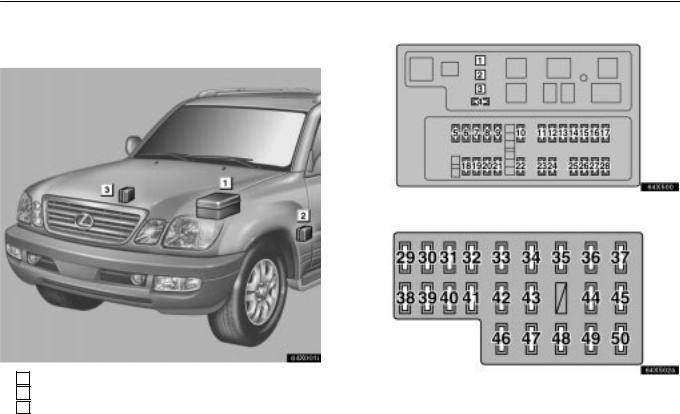
ELECTRICAL COMPONENTS
SPECIFICATIONS |
± FUSES |
||
± FUSE LOCATIONS |
|
|
|
|
|
|
|
|
|
|
|
|
|
|
|
|
|
|
|
Engine compartment
|
|
|
|
|
|
|
|
|
|
|
|
|
|
|
|
1 Engine compartment |
|
|
|
||||
|
|
|
|||||
|
|
|
|||||
Driver's side kick panel |
|||||||
2 |
Driver's side kick panel |
||||||
|
|
|
|||||
3 |
Passenger's side kick panel |
|
|
|
|||
400
